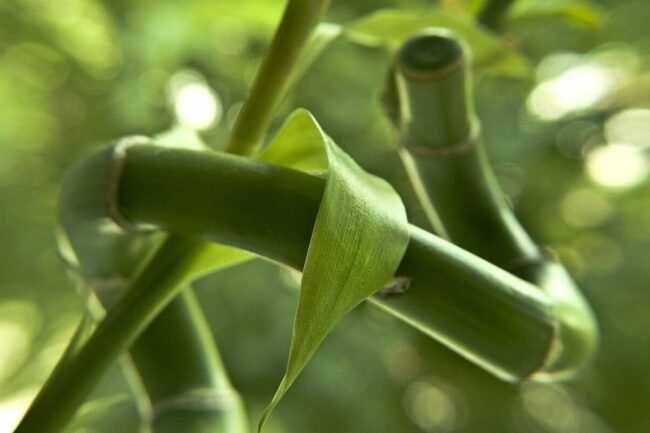Do you have a lucky bamboo plant at home that’s starting to get a bit unruly? Are you wondering how to prune and shape lucky bamboo to keep it looking its best? Well, you’re in luck! In this article, we’ll dive into the art of pruning and shaping lucky bamboo, helping you master this simple yet effective technique.
Whether you’re a beginner or an experienced houseplant enthusiast, we’ll provide you with practical tips and step-by-step guidance on how to prune and shape lucky bamboo to keep it thriving and looking beautiful. So, let’s get started and learn the secrets to maintaining the perfect lucky bamboo plant!
How to Prune and Shape Lucky Bamboo
Lucky bamboo, also known as Dracaena sanderiana or ribbon plant, is a popular indoor plant that is believed to bring good luck and prosperity. It’s easy to care for, resilient, and can enhance the aesthetic appeal of any space. One important aspect of lucky bamboo care is pruning and shaping. Pruning helps promote growth, maintain the plant’s shape, and keep it healthy.
In this article, we will guide you through the process of pruning and shaping lucky bamboo to ensure its longevity and beauty.
The Importance of Pruning Lucky Bamboo
Pruning is essential for maintaining the health and aesthetics of lucky bamboo. Here are a few reasons why pruning is important:
1. Growth Control: Lucky bamboo can grow rapidly under suitable conditions. Pruning helps control its growth, preventing it from becoming too tall or overgrown.
2. Aesthetic Appeal: Regular pruning ensures that the plant maintains a desirable shape and appearance, enhancing its visual appeal as a decorative element in your home or office.
3. Health Maintenance: Removing dead or yellowing leaves and stems promotes the overall health of the plant, preventing the spread of diseases or pests.
Tools Required for Pruning Lucky Bamboo
Before you start pruning your lucky bamboo, gather the following tools:
1. Clean, sharp scissors or pruning shears: Make sure your tools are sterilized to prevent the transfer of diseases between plants. You can clean them with rubbing alcohol or a diluted bleach solution.
2. Clean water: Have a container of clean water nearby to place the cuttings in after pruning.
Read More: About Fine Spray Watering Can for Seedlings: The Benefits
Step-by-Step Guide to Pruning Lucky Bamboo
Follow these steps to effectively prune and shape your lucky bamboo plant:
- Assess the plant: Start by examining the plant and identifying any dead or yellowing leaves or stems that need to be pruned. Look for any overcrowded areas that could benefit from thinning out.
- Choose the appropriate height: Decide on the desired height for your lucky bamboo plant. Keep in mind that cutting the main stalk will result in branching from the cut area.
- Trim the leaves: Using clean scissors or pruning shears, carefully trim any dead, yellow, or damaged leaves. Cut at an angle to avoid sharp edges that could poke or injure the plant or yourself.
- Thin out crowded areas: If you notice that some stems are overcrowded, consider removing a few to promote airflow and prevent the growth of mold or mildew. Choose stems that are weaker or growing in awkward directions and cut them at the base.
- Prune the main stalk: If you want to control the height of your lucky bamboo or encourage branching, cut the main stalk just above a node or joint. This will stimulate new growth from that point and result in a bushier appearance.
- Place cuttings in water: After pruning, place the cuttings in a container of clean water. This allows them to continue growing and potentially develop roots, which can be planted to create new lucky bamboo plants.
- Dispose of pruned parts: Properly dispose of the pruned parts by composting or discarding them. Do not leave them lying around, as they can attract pests or diseases.
Shaping Lucky Bamboo
Shaping lucky bamboo is another way to enhance its beauty and customize its appearance. Here are a few techniques to shape your lucky bamboo:
1. Twisting: Gently twist the stems of the lucky bamboo to create a spiral shape. This technique works best on younger plants with more flexible stems. Be careful not to exert too much pressure to avoid damaging the plant.
2. Training: Use plant ties or soft wires to gently guide the stems into the desired shape. This method requires patience and regular monitoring to prevent the ties from digging into the plant’s stems.
3. Topiary: Experiment with pruning to create different topiary shapes, such as hearts, pyramids, or braids. With careful trimming and shaping, you can turn your lucky bamboo into a unique and eye-catching centerpiece.
Tips for Pruning and Shaping Lucky Bamboo
Consider the following tips to ensure successful pruning and shaping of your lucky bamboo:
– Prune and shape lucky bamboo during its active growth phase, typically in spring or early summer. Avoid heavy pruning during the dormant period.
– Regularly clean and sterilize your pruning tools to prevent the spread of diseases.
– Use sharp scissors or pruning shears to achieve clean cuts and minimize damage to the plant.
– Avoid over-pruning, as it may weaken the plant. Aim to remove no more than one-third of the plant’s foliage at a time.
– Monitor the plant’s response after pruning and adjust your care routine accordingly to facilitate healthy growth.
With proper pruning and shaping, your lucky bamboo will not only thrive but also become an exquisite addition to your indoor space. Remember to enjoy the process and get creative with different shapes and arrangements.
Read More: About How to Prune a Flamingo Tree?
Frequently Asked Questions (FAQs)
The best time to prune lucky bamboo is during spring or early summer when it is actively growing.
Yes, you can use regular scissors to prune lucky bamboo. Just make sure they are clean and sharp.
When pruning lucky bamboo stalks, it is recommended to trim them down to the desired height, leaving at least one node (joint) on each stalk.
Yes, you can propagate lucky bamboo from the cuttings. Simply place the cuttings in water, ensuring that at least one node is submerged. Roots should start to grow within a few weeks.
Pruning lucky bamboo helps to promote new growth, improve the overall appearance, and maintain its desired shape.
Pruning lucky bamboo is not required frequently. You can trim it as needed to maintain its shape or size.
If you accidentally prune too much from your lucky bamboo, don’t worry! It will most likely recover on its own. Just make sure it is still placed in water and receives adequate light and care.
Yes, you can prune the leaves of lucky bamboo if they become too long or damaged. Use clean scissors to trim them back to the desired length.
Final Thoughts
In conclusion, knowing how to prune and shape lucky bamboo is essential for maintaining its health and promoting growth. Regular pruning helps control the size and shape of the plant, while shaping allows for creative and decorative arrangements. By removing excess growth, damaged or yellowing leaves, and promoting new shoots, you can ensure your lucky bamboo remains vibrant and lush.
Remember to use clean and sharp tools, make clean cuts at an angle, and consider the overall design aesthetic when pruning and shaping. With these tips, you can successfully maintain and enhance the beauty of your lucky bamboo.
Auto Amazon Links: No products found.
Perfect Plants Christmas Tree Saver 8oz. | Easy Use Xmas Tree Preserver Food | Have Healthy Green Christmas Trees All Holiday Season
$9.97 (as of December 3, 2025 00:36 GMT +00:00 - More info- Product prices and availability are accurate as of the date/time indicated and are subject to change. Any price and availability information displayed on [relevant Amazon Site(s), as applicable] at the time of purchase will apply to the purchase of this product.
Kaiedos Christmas Tree Watering Funnel - 39 Inch Funnel, Reusable Design, Makes Watering Your Live Tree a Snap!
$14.99 (as of December 3, 2025 00:36 GMT +00:00 - More info- Product prices and availability are accurate as of the date/time indicated and are subject to change. Any price and availability information displayed on [relevant Amazon Site(s), as applicable] at the time of purchase will apply to the purchase of this product.
Christmas Tree Watering Funnel, Real Christmas Tree Water Long Funnel About 40 Inch, Trees Watering System for Water Indoor Outdoor
$15.99 (as of December 3, 2025 00:36 GMT +00:00 - More info- Product prices and availability are accurate as of the date/time indicated and are subject to change. Any price and availability information displayed on [relevant Amazon Site(s), as applicable] at the time of purchase will apply to the purchase of this product.
IPOOLTENG Christmas Tree Watering Funnel 3 Tube 1 Funnels 40 Inch - 3 Section Plastic Christmas Tree Funnel Waterer, Long Funnels for Watering Trees, Best Gifts for Your Parents to Water Tree
$15.53 (as of December 3, 2025 00:36 GMT +00:00 - More info- Product prices and availability are accurate as of the date/time indicated and are subject to change. Any price and availability information displayed on [relevant Amazon Site(s), as applicable] at the time of purchase will apply to the purchase of this product.
1 Pack Christmas Tree Watering Funnel System, 44 Inch Christmas Tree Watering Stick with Adjustable 3-Section Design, Reusable & Spill-Free, Xmas Plant Waterer Tool for Indoor and Outdoor
$16.99 (as of December 3, 2025 00:36 GMT +00:00 - More info- Product prices and availability are accurate as of the date/time indicated and are subject to change. Any price and availability information displayed on [relevant Amazon Site(s), as applicable] at the time of purchase will apply to the purchase of this product.
Cuisinart 6.5" Cast Iron Smashed Burger Press, Round Flat Edge Grill Press for Crispy Smash Burgers, Burger Tool for Grill and Griddle Accessories, for BBQs and Tailgates
$9.99 (as of November 30, 2025 15:21 GMT +00:00 - More info- Product prices and availability are accurate as of the date/time indicated and are subject to change. Any price and availability information displayed on [relevant Amazon Site(s), as applicable] at the time of purchase will apply to the purchase of this product.
Muddy Mat® Shown on TV Super Absorbent Microfiber Dog Door Mat for Muddy Paws, Non-Slip Washable Pet Rug, Quick Dry Chenille Entryway Carpet, Machine Washable Indoor Outdoor mat, Grey 30"x19"
$18.78 (as of November 30, 2025 15:21 GMT +00:00 - More info- Product prices and availability are accurate as of the date/time indicated and are subject to change. Any price and availability information displayed on [relevant Amazon Site(s), as applicable] at the time of purchase will apply to the purchase of this product.
Zevo Flying Insect Trap Official Refill Cartridges - Fits Both Zevo Trap & MAX Indoor Fly Trap - Authentic Trap+Lock Technology to Catch Gnats, House & Fruit Flys (4 Official Refill Cartridges)
$14.97 (as of November 30, 2025 15:21 GMT +00:00 - More info- Product prices and availability are accurate as of the date/time indicated and are subject to change. Any price and availability information displayed on [relevant Amazon Site(s), as applicable] at the time of purchase will apply to the purchase of this product.
ThermoPro TP16 Large LCD Digital Cooking Food Meat Thermometer for Smoker Oven Kitchen BBQ Grill Thermometer Clock Timer with Stainless Steel Temperature Probe
$17.99 (as of November 30, 2025 15:21 GMT +00:00 - More info- Product prices and availability are accurate as of the date/time indicated and are subject to change. Any price and availability information displayed on [relevant Amazon Site(s), as applicable] at the time of purchase will apply to the purchase of this product.
TERRO Ant Killer Bait Stations T300B - Liquid Bait to Eliminate Ants - Bait System - 12 Count Stations for Effective Indoor Ant Control
$10.86 (as of November 30, 2025 15:21 GMT +00:00 - More info- Product prices and availability are accurate as of the date/time indicated and are subject to change. Any price and availability information displayed on [relevant Amazon Site(s), as applicable] at the time of purchase will apply to the purchase of this product.











